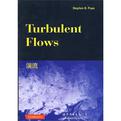湍流
出版时间:2010-4 出版社:世界图书出版公司 作者:波普 页数:771
Tag标签:无
前言
This book is primarily intended as a graduate text on turbulent flows forengineering students,but it may also be valuable to students in atmosphericsciences,applied mathematics,and physics,as well as to researchers andpracticing engineers.The principal questions addressed are the following.(i) how do turbulent flows behave?(ii)HOW can they be described quantitativelv?(iii)What are the fundamental physical processes involved?(iv)HOW can equations be constructed to simulate or model the behaviorof turbulent flows?In 1 972 Tennekes and Lumley produced a textbook that admirably ad. dresses the first three of these questions .In the intervening years. due inpart to advances in computing,great strides have been made toward pro-viding answers to the fourth question. Approaches such as Reynolds-stressmodelling,probability-density-function(PDF)methods,and large-eddy sim-ulation(LES)have been developed that,to an extent,provide quantitativemodels for turbulent flows.Accordingly,here(in Part II)an emphasis isplaced on understanding how model equations can be constructed to de.scribe turbulent flows:and this objective provides focus to the first threequestions mentioned above(which are addressed in Part I).However,incontrast to the book by Wilcox f1993),this text iS not intended to be apractical guide to turbulence modelling.Rather,it explains the concepts anddevelops the mathematical tools that underlie a broad range of approaches.There iS a vast literature on turbulence and turbulent flows,with manyworthwhile questions addressed by many difierent approaches.
内容概要
本书是一部研究生湍流教程,是以作者在Cornell大学数年的教学讲义为基础,用最新颖的观点,全面综合讲述湍流这一流体动力学的重要组成部分。全书的内容分为两个组成部分,并且附有大量的附录,第一部分集中介绍湍流的基本知识,其工作原理,以及如何量化,也包括基本物理过程;第二部分介绍了跟湍流模型和模拟有关的各种方法;附录部分增加了理解本书所必需的数学技巧。目次:(第一部分)基础:导引;流体运动方程;湍流的统计描述;均值流动方程;自由剪切流;湍流运动尺度;壁流;(第二部分)模型和仿真:模型和仿真引入;直接数值模拟;湍流涡粘度模型;雷诺应力及其相关模型;PDF方法;大涡模拟;(第三部分)附录。 读者对象:适用于工程运用物理专业研究生水平的学生,应用数学专业,物理,海洋学、大气科学等方向的科研人员。
作者简介
作者:(美国)波普(Stephen B.Pope)
书籍目录
List of tables Preface Nomenclature PART ONE: FUNDAMENTALS 1 Introduction 1.1 The nature of turbulent flows 1.2 The study of turbulent flows 2 The equations of fluid motion 2.1 Continuum fluid properties 2.2 Eulerian and Lagrangian fields 2.3 The continuity equation 2.4 The momentum equation 2.5 The role of pressure 2.6 Conserved passive scalars 2.7 The vorticity equation 2.8 Rates of strain and rotation 2.9 Transformation properties 3 The statistical description of turbulent flows 3.1 The random nature of turbulence 3.2 Characterization of random variables 3.3 Examples of probability distributions 3.4 Joint random variables 3.5 Normal and joint-normal distributions 3.6 Random processes 3.7 Random fields 3.8 Probability and averaging 4 Mean-flow equations 4.1 Reynolds equations 4.2 Reynolds stresses 4.3 The mean scalar equation 4.4 Gradient-diffusion and turbulent-viscosity hypotheses 5 Free shear flows 5.1 The round jet: experimental observations 5.2 The round jet: mean momentum 5.3 The round jet: kinetic energy 5.4 Other self-similar flows 5.5 Further observations 6 The scales of turbulent motion 6.1 The energy cascade and Kolmogorov hypotheses 6.2 Structure functions 6.3 Two-point correlation 6.4 Fourier modes 6.5 Velocity spectra 6.6 The spectral view of the energy cascade 6.7 Limitations, shortcomings, and refinements 7 Wall flows 7.1 Channel flow 7.2 Pipe flow 7.3 Boundary layers 7.4 Turbulent structures PART TWO: MODELLING AND SIMULATION 8 An introduction to modelling and simulation 8.1 The challenge 8.2 An overview of approaches 8.3 Criteria for appraising models 9 Direct numerical simulation 9.1 Homogeneous turbulence 9.2 Inhomogeneous flows 9.3 Discussion 10 Turbulent-viscosity models 10.1 The turbulent-viscosity hypothesis 10.2 Algebraic models 10.3 Turbulent-kinetic-energy models 10.4 The k-εmodel 10:5 Further turbulent-viscosity models 11 Reynolds-stress and related models 11.1 Introduction 11.2 The pressure-rate-of-strain tensor 11.3 Return-to-isotropy models 11.4 Rapid-distortion theory 11.5 Pressure-rate-of-strain models 11.6 Extension to inhomogeneous flows 11.7 Near-wall treatments 11.8 Elliptic relaxation models 11.9 Algebraic stress and nonlinear viscosity models 11.10 Discussion 12 PDF methods 12.1 The Eulerian PDF of velocity 12.2 The model velocity PDF equation 12.3 Langevin equations 12.4 Turbulent dispersion 12.5 The velocity-frequency joint PDF 12.6 The Lagrangian particle method 12.7 Extensions 12.8 Discussion 13 Large-eddy simulation 13.1 Introduction 13.2 Filtering 13.3 Filtered conservation equations 13.4 The Smagorinsky model 13.5 LES in wavenumber space 13.6 Further residual-stress models 13.7 Discussion PART THREE: APPENDICES Appendix .4 Cartesian tensors A.1 Cartesian coordinates and vectors A.2 The definition of Cartesian tensors A.3 Tensor operations A.4 The vector cross product A.5 A summary of Cartesian-tensor suffix notation Appendix B Properties of second-order tensors Appendix C Dirac delta functions C.1 The definition of δ(x) C.2 Properties of rS(x) C.3 Derivatives of rS(x) C.4 Taylor series C.5 The Heaviside function C.6 Multiple dimensions Appendix D Fourier transforms Appendix E Spectral representation of stationary random processes E.1 Fourier series E.2 Periodic random processes E.3 Non-periodic random processes E.4 Derivatives of the-process Appenthix F The discrete Fourier transform Appendix G Power-law spectra Appendix H Derivation of Eulerian PDF equations Appendix I Characteristic functions Appendix J Diffusion processes Bibliography Author index Subject index
章节摘录
插图:
编辑推荐
《湍流》是由世界图书出版公司出版的。
图书封面
图书标签Tags
无
评论、评分、阅读与下载
用户评论 (总计37条)
- 对于有一定流体力学基础的人来说,该书是一本很好的工具性书籍:对湍流的各种概念进行了描述。阅读该书可以从相应的章节开始,不必逐章看(太厚了,等读到需要的那部分,可能黄花菜就凉了)。即便是这样,也可以感觉到作者深厚的功底和清晰的思路。当然如果需要了解最前沿的东西,可能还需要查找相应的文献。
- 内容还没看,不过听说很好的书。大致看了一下,内容很全面,比较系统的介绍了湍流的相关内容。
- 湍流经典好书,比大多数国内教材好
- 很好的学习湍流的书。。。
- 非常全,并且有一定的系统性。适合刚接触湍流的兴趣者。
- 英文原著,内容翔实。包含理论部分和数值模拟部分,很值得拥有一本。
- 基本的模型都讲到了
- 非常适合学流体的用
- 基础理论教程,很实用
- 这么专业的书,这里有,太好了!
- 英语水平有待提高
- 质量很好,内容丰富,在看
- 没怎么看过,但是这书确实非常有名。
- 应该是好书,抽时间好好研究研究
- 不知道有没有译文版的书咧,看英文还是稍微有点吃力。
- 很实用,可以短时间就复习好
- 就是太厚重了,可能纸张太好了
- 书不错,是讲湍流比较好的书籍了,但是由于湍流本身就比较复杂,所以这本书也不简单,需要认真看。
- 还没看,这么厚厚的一本英文书还是吓着我了
- 国内现在能买到的 湍流的经典著作吧 二版的纸张和印刷比一版的要好很多 比期望的要好 不过图书的书角有一些折痕 可能是运输过程中留下来的吧 无所谓了 至于内容等看完了再评
- 算是市面上比较专业的一本书。
- 内容很详细,非常值得收藏
- 又大又厚,里面的字也比较大,相信读起来会很流畅
- 算是廉价的盗版国外的书,不错,可以收藏
- 值得收藏的经典著作.
- 只要你搜索了这书,看见了这个评论,就说明你肯定是同道了。那这本书就不用介绍了,绝对的好书和非常有用的工具书。书影印的不错,只是有些快递造成的碰痕。这个价格绝对值。在美国的时候没下得了手买80几刀的美版,回来后特意买了一本。希望多引进这样的影印书。强力推荐!
- 比那本计算流体动力学导论印刷质量好多了。
- 比较适合做模拟的,做理论还是看Statistical Fluid Mechanics卷1,2
- 印刷质量很好,就是纸有点薄。经典教材,写的很好。
- 很不错,印刷很好,慢慢看了
- 书没看……不过质量非常不错,印刷非常好,卖家包装的也很结实
- 不错!纸张好,等待研究。
- 内容和书的质量都还可以
- 纸的质量也不错,书本身也很好。
- 不错的原版影印书,问题讲得透彻,可能是比较少有人购买的原因,表面有点破损,但无伤大雅。
- 书印刷还行,而且送的速度挺快,下雨了还是隔天拿到了,嘿嘿
- 印刷质量比introduction to computational fluid dynamics好得多。
相关图书
- 暂G(ZD)课标物理8上(人教版)/状元笔记
- 暂G(ZD)课标语文8上(语文版)/状元笔记
- 暂G(ZD)课标英语8上(外研版)/状元笔记
- 暂G课标高中数学必修1(人教版)/状元笔记教材详解
- 暂G(ZD)课标英语8上(外研版)/三点一测
- 暂G课标高中政治必修1(人教版)/经纶学典精讲精练
- 暂G课标物理9上(人教版)/经纶学典教材解析
- 暂G课标数学8上(华师版)/经纶学典教材解析
- GB/T50082—2009 普通混凝土长期性能和耐久性能试验方法标准
- 教师综合素质提高丛书修订
- 教师的课堂管理艺术
- 将棋入门一月通
- 桥梁和隧道
- 什么是什么
- 让阅读如呼吸一样自然(温馨感人卷)
- 中国市场规制体系改革的经济学研究
- 数学
- 语文
- 物理
- 全能学练教材1+1九年级化学上
- 全能学练教材1+1九年级物理上
- 全能学练教材1+1九年级英语上
- 奇速英语·原创阅读理解·完形·写作·听力
- 全能学练教材1+1九年级数学上
- 物理
